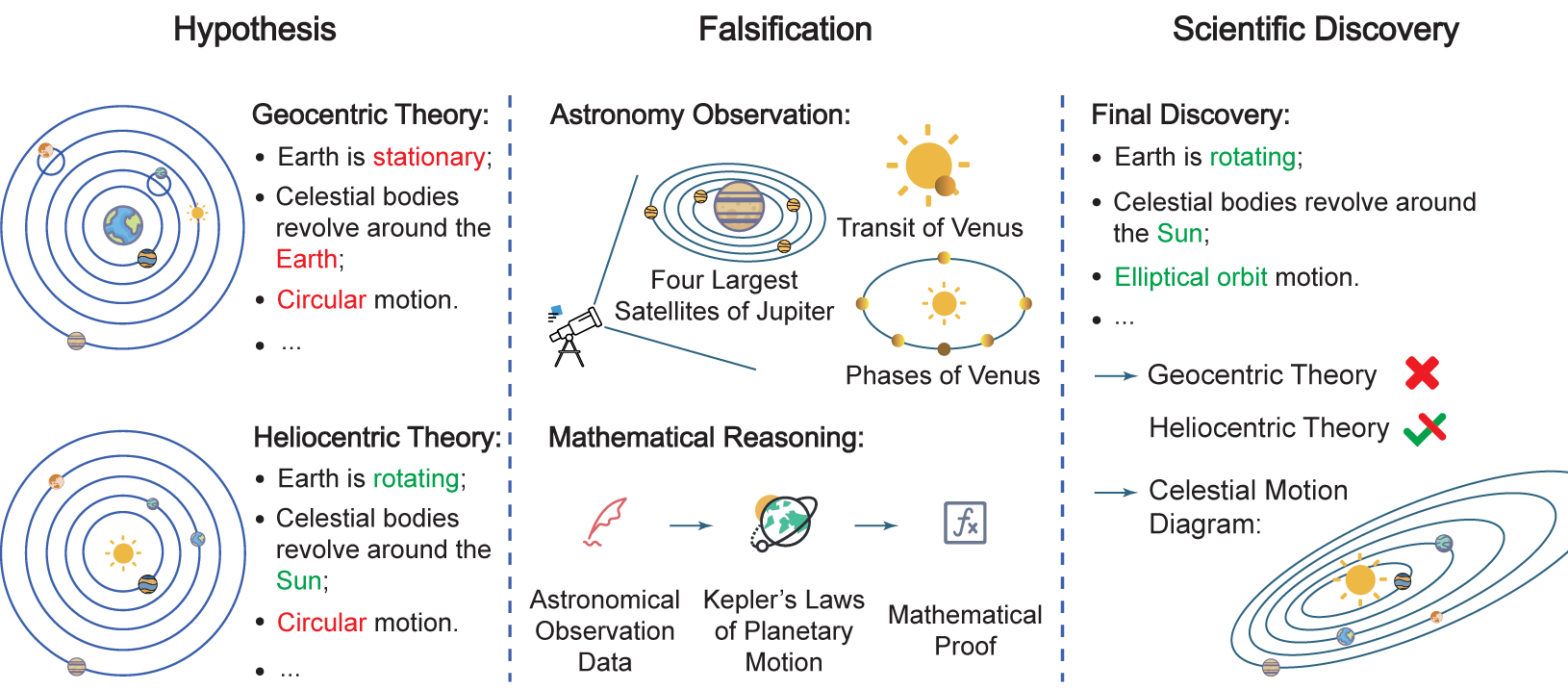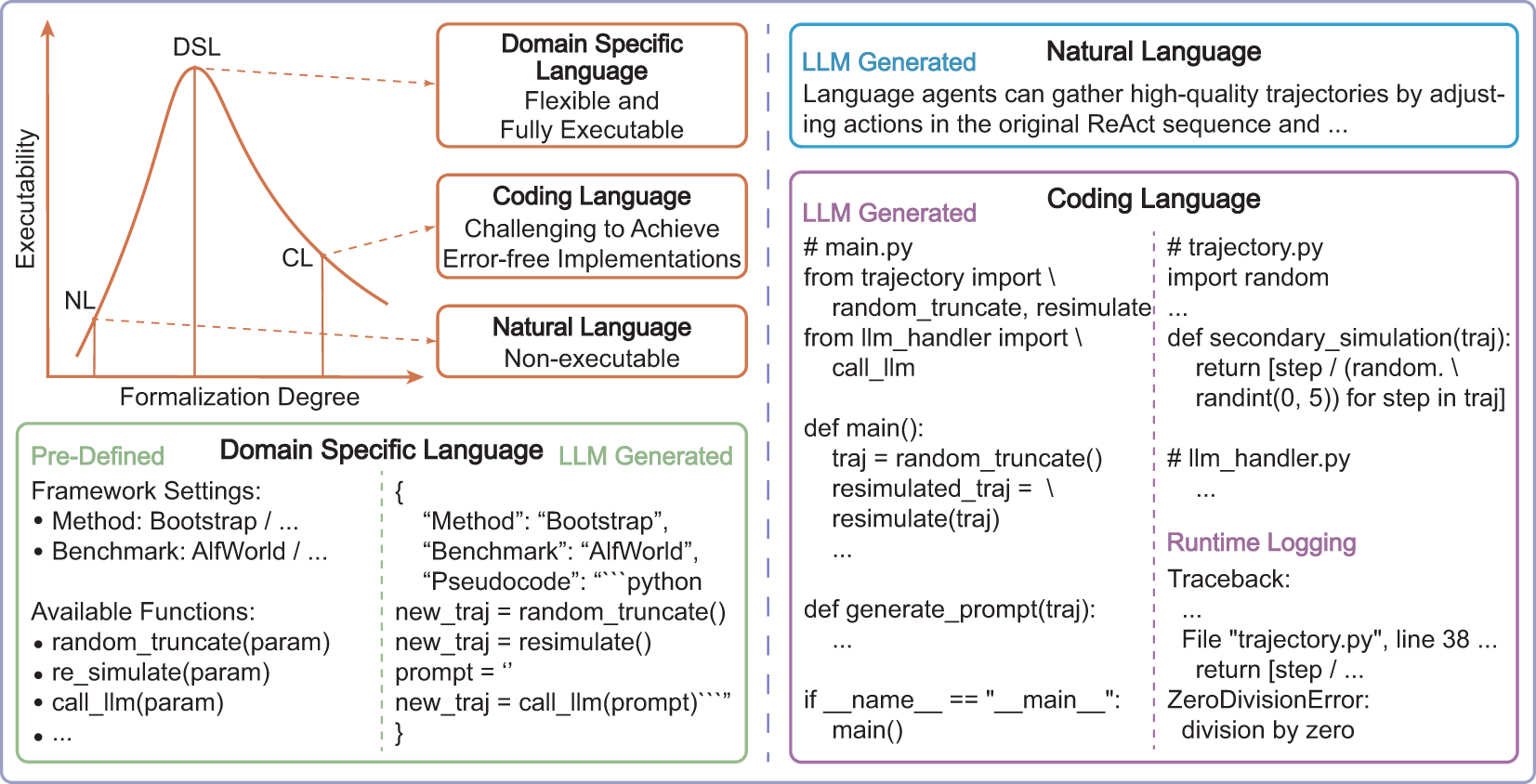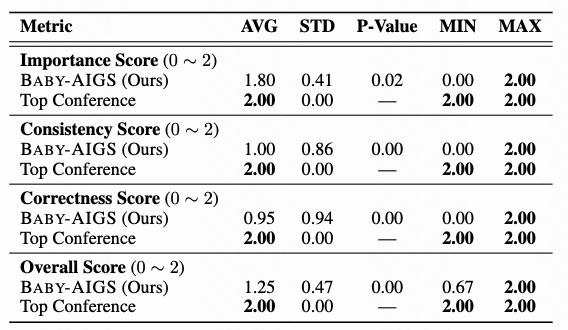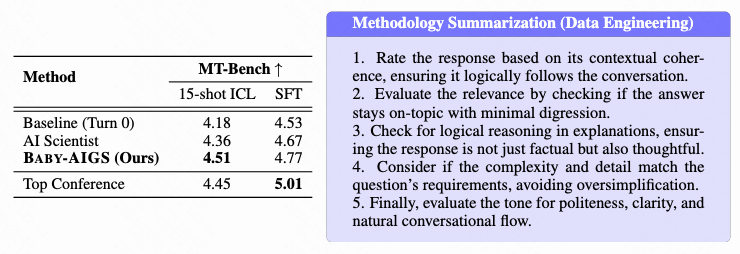
Abstract
The recent rise of Large Language Models (LLMs) and the empowered autonomous agents enable scientists to gain help through interaction in different stages of their research, including but not limited to literature review, research ideation, idea implementation, and academic writing. However, AI researchers instantiated by foundation model empowered agents with full-process autonomy are still in their infancy. In this paper, we study AI-Generated Science (AIGS), where agents independently and autonomously complete the entire research process and discover scientific laws. By revisiting the definition of scientific research (Popper, 1935), we argue that falsification is the essence of both human research process and the design of an AIGS system. Through the lens of falsification, prior systems attempting towards AI-Generated Science either lack the part in their design, or rely heavily on existing verification engines that narrow the use in specialized domains. In this work, we propose Baby-AIGS as a baby-step demonstration of a full-process AIGS system, which is a multi-agent system with agents in roles representing key research process. By introducing FalsificationAgent, which hypothesize and then verify possible scientific discoveries, we empower the system with explicit falsification. We also incorporate techniques to boost overall executability of experiment plans and creativity during ideation. Experiments on three tasks preliminarily show that Baby-AIGS could produce meaningful scientific discoveries, though not on par with experienced human researchers.
Four Paradigms of AI-accelerated Scientific Discovery
We review and envision the development of AI-accelerated scientific discovery as four paradigms:

(I) AI as a Performance Optimizer, where deep neural networks are trained with large-scale observation data in a specific scientific problem to extract the patterns in an end-to-end manner.
(II) AI as a Research Assistant, where LLM-driven research copilots are used to assist the human research process.
(III) AI as an Automated Scientist. In this regime, foundation model empowered agents with scientist-like behavior should complete the entire research process, ranging from the initial idea proposal to the ultimate delivery of the scientific findings.
(IV) AI Forms a Research Community. Upon the prosperity of fully-autonomous AI researchers depicted in the previous stage, we envision the collaborations among the agentic researchers foster an AI-formed research community.
Principles of A Full-process AIGS System
When constructing an AIGS system with full-process autonomy, the desiderata of the system design should refer to the full process of scientific research process. While it is widely-believed that creativity is indispensable in the process of research - which is also accounted in previous work - the central component of scientific research is falsification: designing and executing experiments to validate or refute hypotheses, and falsified hypotheses pose positive contributions to scientific progress as well (ml-retrospectives). Moreover, experienced researchers accumulate practical skills or reusable workflows (Gil et al., 2007) from hands-on experimentation, which eases the design and execution of experiments and hypothesis falsification. The abstraction of workflows in experiments enables effective reuse, which reflects a high level of executability in scientific research.
To recapitulate, a creative idea is the beginning of a piece of scientific research, followed by experiments to be conducted; executability forms the basis for falsification, and a sequence of logically consistent falsification processes turns a novel idea into scientific discoveries with genuine creativity. Therefore, falsification is the foundation of AI-Generated Science, pillared by experimenting scaffolds accounting for executability and targeting at the ultimate goal of creativity.
Baby-AIGS: A Baby Step Towards Full-Process AIGS
In our Baby-AIGS system, we recognize that scientific research typically involves the following major phases: literature review, idea formation, methodology design, experiment execution, result analysis, and ablation study. These phases form an iterative circle, with scientific discoveries often emerging through repeated iterations of this process.

Aiming at building our system more human-like to benefit from these insights, we model the construction of the agents on these phases. Specifically, LiteratureAgent is responsible for literature review, ProposalAgent is responsible for idea formation and methodology design, ExperimentAgent conducts experiment execution, ReviewAgent handles result analysis and FalsificationAgent carries out ablation studies. In the following, we introduce two most important designs in our system.

(i) DSL: As shown in the picture, we introduce an important but not yet proposed design of the AIGS system: Domain Specific Language (DSL). DSL acts a critical role in constructing a fully autonomous AIGS pipeline. Specifically, DSL is a pre-designed, structured object output directly by ProposalAgent, which can help interpret the generated idea and methodology into system executable code. For instance, in a deep learning task, DSL can directly be the code to train the model, and in a chemistry experiment, DSL can be the action to manipulate a microscope. In this manner, DSL bridges the gap between proposal formulation and experimental execution, effectively addressing the issue of improperly executed proposals.
(ii) FalsificationAgent in the Baby-AIGS system conducts an explicit process of falsification by verifying experimental discoveries through systematic ablation studies. It analyzes experimental records, including proposals, results, and reviews, to identify factors contributing to significant improvements. By examining entire chains of iterations, it derives scientific discovery candidates and proposes targeted ablation studies to isolate and validate specific causes behind improvements. Using repeated experiments on both baseline and ablation setups, FalsificationAgent confirms whether a discovery consistently holds true, ensuring only robust scientific principles are validated.
Experiment Setup and Results
Selected Research Topics
-
Data Engineering: The task is to identify key distinguishing features of high-quality datasets, which allows Baby-AIGS to filter and extract high-quality data subsets. Through this approach, Baby-AIGS seeks to enhance data quality and relevance, making downstream tasks more effective.
-
Self-Instruct Alignment: This task involves constructing an optimal set of seed instructions and using these to iteratively generate an instruction-response dataset for enhanced model self-instruction. By refining the alignment between instructions and responses, Baby-AIGS aims to improve the model’s capacity for autonomous learning and adaptation.
-
Language Modeling: In this task, Baby-AIGS experiments with various structural adjustments to language models with the aim of improving pre-training outcomes. Through architecture exploration, the system seeks to enhance both model efficiency and the quality of generated text, as reflected in metrics like perplexity.
Evaluation
We evaluate Baby-AIGS based on three key principles central to AIGS systems: falsification, creativity, and executability.
Falsification: We assess Baby-AIGS’s ability to perform falsification through human evaluation, focusing on the falsification process carried out by FalsificationAgent.

The results show that Baby-AIGS could produce valid scientific discoveries through falsification, but there are two critical findings that indicate further improvement is needed.
-
The average value of the importance score is higher than the consistency and correctness score, indicating that FalsificationAgent could identify important factors potentially related to a scientific discovery but failed to design a concrete experiment plan and verify the hypothesis.
-
The p-values indicate that the falsification process of Baby-AIGS is significantly less satisfactory than the existing literature from top conferences from human perspectives.
Creativity: We measure the creativity of Baby-AIGS by evaluating the performance improvement of the proposed idea and methodology against the baseline result, i.e., the result from the trivial methodology on the test benchmarks.



The results of our three tasks show that Baby-AIGS outperforms the baseline method, demonstrating the system’s creativity in ideation and corresponding method design.
- For data engineering, Baby-AIGS outperforms AI Scientist with a significant margin, demonstrating the effectiveness of the enriched feedback, including multi-granular metrics, verbose review on both experiment process and methodology design, etc., in exploring research idea.
- However, the result of SFT alignment is inferior than Deita (Liu et al., 2024), indicating that the lack of validation benchmarking of specific downstream tasks might result in an suboptimal outcome.
Executability: We measure the executability of Baby-AIGS by comparing the success rates on three selected tasks of AI Scientist (Lu et al., 2024) and Baby-AIGS.

Our quantitative analysis highlights significant improvements in executability, with Baby-AIGS achieving nearly 100% success rates in translating the generated ideas into experimental results and the final scientific discovery. This high executability, attributed to our DSL design for errorless experimentation, prevents restarting from in-process failures and enables an efficient automated research process.
Discussions
Q1: Why is falsification important in automated research systems?
Falsification is essential in automated research systems as it provides a rigorous mechanism for hypothesis testing, a core component in the scientific method. In Baby-AIGS, FalsificationAgent plays a crucial role in formulating hypotheses, systematically isolating experimental variables, and conducting ablations to validate scientific insights. This approach ensures that the system not only generates hypotheses but also actively challenges and refines them, producing reliable knowledge with minimized biases. Without falsification, the system could misinterpret or overfit patterns within datasets, leading to less generalizable scientific findings.
Q2: How does the Baby-AIGS system boost creativity?
Baby-AIGS enhances creativity by integrating a multi-sampling approach combined with re-ranking, allowing it to generate diverse research proposals and rank them based on validation benchmarks. This process, facilitated by ProposalAgent, enables the generation of unique and innovative ideas, pushing the boundaries of traditional benchmarks. In tasks like *Self-Instruct Alignment*, Baby-AIGS shows substantial creativity, generating novel instruction datasets that improve alignment quality. This iterative proposal refinement and re-ranking process adds a layer of quality assurance, driving high creative output in various scientific domains.
Q3: Why could DSL help with conductibility?
The use of a Domain-Specific Language (DSL) in Baby-AIGS facilitates conductibility by providing a structured and executable representation of ideas and methodologies proposed by ProposalAgent. DSL enhances the system’s ability to translate complex scientific workflows into actionable experiment plans. In our experiments, DSL significantly improved success rates in generating scientifically valuable outcomes, underscoring its role in achieving high executability. This abstraction of executable workflows allows Baby-AIGS to transition seamlessly from ideation to experimentation, reducing ambiguity and ensuring consistent, reproducible research outcomes.
Actionable Insights
Envisioning the future of AI-generated science systems powered by foundation models in real-world, in this section, we provide insights on the next steps of research from AIGS.
Balance idea diversity and experimental conductibility.
The design of the DSL enhances the conductibility of ideas but may constrain creativity. Therefore, achieving a balance between idea diversity and experimental conductibility requires further empirical analysis, with one potential avenue being enabling agents to develop their own DSLs.
Establish systematic mechanisms for evaluation and feedback.
The quality of AIGS system depends heavily on rigorous evaluation of prior proposals, methods, and results. Future work should explore systematic mechanisms to analyze outcomes across iterations, maximizing experience transfer and continuous improvement.
Strengthen the falsification procedure.
Our research underscores the importance of falsification to enhance the scientific rigor of the research findings. While we have prototyped the falsification process in our multi-agent AIGS system, more efforts are required to strengthen the modules related to knowledge falsification.
Expand channels for scientific knowledge dissemination.
While ([Lu et al., 2024](https://arxiv.org/abs/2408.06292)) focus on disseminating knowledge through research papers, alternative formats like posters, podcasts, and videos are gaining traction with the rise of multi-modal agents. Future research should also explore more efficient communication channels between AI systems, beyond structured text or natural language.
Investigate the communication dynamics among the agentic researchers.
The long-term vision for AIGS systems involves the formation of an AI research community. Therefore, deeper exploration of these interactions, particularly within a multi-agent environment, will be crucial for fostering effective collaborations.
Promote interdisciplinary knowledge integration.
Further developments would extend research systems to address challenges in other scientific fields, such as biology, chemistry, and physics. The major challenge lies in how AI agents can synthesize and align domain-specific knowledge from multiple fields. Furthermore, encouraging collaboration between AI systems working across disciplines may generate more innovative hypotheses and solutions.